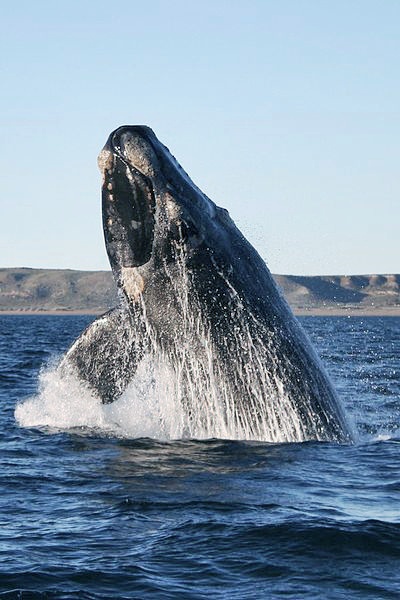KidZone Animals
Whales: Right Whales

"Southern Right whale"; used with permission
under the CC BY-SA 3.0
Right whales of the Eubalaena whale genus are part of the order Mysticeti. Other whales (baleen whales) part of this order are Blue, Humpback, and Gray. Within the genus of Right whales there are three species of whale: the North Atlantic Right whale (Eubalaena glacialis), the North Pacific Right whale (Eubalaena japonica), and the Southern Right whale (Eubalaena autralis). The Right whale was given its name because of its accessibility for whale hunters – in other words, they considered it to be the best whale to hunt (hence, the "right" whale).
The Right whale is a baleen whale, which means that it does not have any teeth but, instead, baleen plates. Unlike the blue whale, which has 400 baleen plates, right whales usually only have between 200-300.
Characteristic of all baleen whales, Right whales have two blowholes (toothed whales have only one). They are usually black, dark brown, or dark gray in color. What visually sets them apart are the rough white skin patches on their heads, known as callosities.
Right whales are very large, weighing up to 200,000 pounds (90,000 kilograms) and measuring up to approximately 18 meters (59 feet) long. Despite their large size, these whales are slow swimmers and shallow divers. When breaching, Right whales cannot fully exit the water (see above image).
And though these whales sometimes feed together in large groups, they are generally solitary whales (the right whale likes its "alone time").
Key Points:
- Genus: Right whales belong to the Eubalaena genus.
- Order: They are part of the order Mysticeti (baleen whales).
- Species: There are three species: North Atlantic Right whale, North Pacific Right whale, and Southern Right whale.
- Physical Characteristics: Two blowholes, black, dark brown, or dark gray color, and rough white skin patches (callosities) on their heads.
- Size: Weigh up to 200,000 pounds (90,000 kilograms) and measure up to 18 meters (59 feet) long.
- Behavior: Slow swimmers, shallow divers, and generally solitary animals.